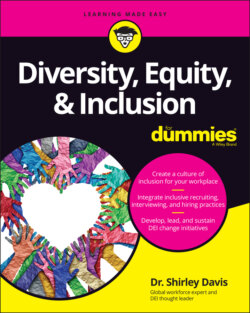Читать книгу Diversity, Equity & Inclusion For Dummies - Dr. Shirley Davis - Страница 13
Understanding the History of Diversity and Inclusion in the Workplace
ОглавлениеDiversity, equity, and inclusion work isn’t new. Human and civil rights movements and laws date back centuries, but understanding the historical context and the many ways that it has evolved over the years is important. This section brings to light the historical societal events that have greatly influenced the diversity, equity, and inclusion shift in the workplace and other institutions.
The Magna Carta (1215), the English Bill of Rights (1689), the French Declaration on the Rights of Man and Citizen (1789), and the U.S. Constitution and Bill of Rights (1791) are the foundations of a long history of the fights for human and civil rights. When they were originally translated into policy, they excluded women, people of color, and members of certain social, religious, economic, and political groups. The Universal Declaration of Human Rights (UDHR) was adopted by the 56 members of the United Nations in 1948, establishing human rights standards and norms.
Since then, more historical events have significantly influenced civil and human rights across the world. In turn, they’ve brought about awareness to the importance of diversity and inclusion practices in the workplace and beyond:
1960 — Sharpeville Massacre (South Africa): In Sharpeville, South Africa, police fired on a group of Black people participating in an anti-apartheid demonstration without provocation.
1963 — March on Washington (United States): Dr. Martin Luther King Jr. delivered his world-famous “I Have a Dream” speech at the March on Washington. In the speech, Dr. King called for civil and economic rights and an end to segregationist policies and racist acts.
1964 — United States Civil Rights Act (United States): This landmark policy put into law the prohibition of discrimination based on race, color, religion, sex, or national origin. It also banned racial segregation in schools, employment, and public entities and unequal voter registration requirements. This act has been amended to include those with disabilities and the LGBTQ community.
1965 — Executive Order 11246 (United States): This order signed by U.S. President Lyndon B. Johnson became a key milestone in a series of federal actions aimed at ending racial, religious, and ethnic discrimination. Also known as Affirmative Action, it protects the rights of workers employed by federal contractors to remain free from discrimination on the basis of their race, color, religion, sex, sexual orientation, gender identity, or national origin and opens doors of opportunity through its affirmative action provisions.
1965 — United States Voting Rights Act (United States): This law prohibits racial discrimination in voting, as well as acts that prohibit a person’s ability to vote.
1965 — United Kingdom Race Relations Act (United Kingdom): This act was the first kind of legislation in the United Kingdom to ban discrimination on the basis of color, race, and ethnic and national origin.
1969 — Stonewall Riots (United States): In response to a police raid at the Stonewall Inn (a gay club in New York City), members of the LGBTQ+ community held a number of violent protests.
1976 — Soweto Uprisings (South Africa): Black schoolchildren held protests in response to the government’s announcement that schooling would take place in Afrikaans, the language based on that of South Africa’s European Dutch settlers.
1987 — publication of Workforce 2000 (United States): Among this book’s predictions was that the future U.S. labor force would include more women and underrepresented groups. Many experts used it as the impetus for creating and making a business case for diversity training.
1994 — Don’t Ask, Don’t Tell (United States): This U.S. military policy prohibited gay, lesbian, and bisexual people from openly serving in the military. In 2011, this policy was dismantled.
2006 — Civil Union Act (South Africa): This South African law established legal civil unions for same-sex marriage and civil unions for unmarried opposite-sex and same-sex couples.
2013 — Marriage Act (United Kingdom): Established legal same sex marriage in England and Wales.
2015 — Equal Marriage Act (United States): The U.S. Supreme Court legalized same-sex marriage in 50 states and required that all states recognize out-of-state same sex marriage licenses.
2020 — Crown Act (United States): This law prohibits discrimination against hairstyles and textures in the state of California.
2020 — George Floyd murder (United States): George Floyd, a Black man, was murdered by a white police officer who held his knee on George Floyd’s neck for more than nine minutes, cutting off his ability to breathe. This event triggered massive outrage, outcries, and international protests for social justice reform and for greater equity and inclusion.
The laws (from various countries across the globe) have evolved in a sequential process from basic human and civil rights to matters of compliance and then the moral and social imperative. As this book explores, organizations’ policies and practices related to DEI matters tend to follow a similar evolutionary process. This similarity leads to a universal experience for diversity, equity, and inclusion programs: They’re normally initiated with awareness and affinity programs, followed by the establishment of the business case for diversity practices. Keep in mind the local, regional, and national laws vary depending on your location.
Also consider that these social movements, those of the 1960s especially, strived more for racial and gender equality, but not within the specifics of diversity, equity, and inclusion. Therefore, examining these terms (as I do in the following section) and how they’ve evolved into workplace standards and benchmarks is important.
